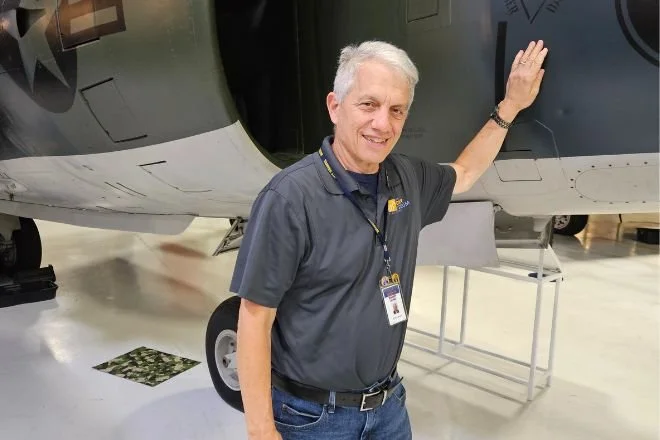From Cargo to Combat: Barry Levine to speak at The War Memorial
GROSSE POINTE FARMS Oct. 6, 2025 – It’s the airman and crewmembers of the AC-119 that made the difference in battle.
That’s one of the messages that Barry Levine will bring with him on Nov. 2 when he comes to The War Memorial for “The AC-119 Gunships: From Cargo to Combat.”
“You can have all of the airplanes you want, but if you don’t have dedicated and well-trained crews that are engaged and support the mission, you’re not going much of anywhere,” he said.
The event begins at 2 p.m. in the Fred M. Alger Center Community Room. Levine’s appearance is part of The War Memorial’s yearlong Vietnam War Commemoration Celebration.
Levine, of Canton, grew up in Hartford, Connecticut. A few job searches later, he ended up in metro Detroit in 1990. His father, Sam Levine, was in the Army Air Corps during World War II.
The 70-year-old Levine attended Boston University, graduating with a degree in accounting.
“There’s my career, and then there’s spare time stuff,” he said. “When I started reading some of these accounts about the World War II guys and what they did and the conditions they did it under were just astonishing. Any mission could be your last. I’m not a pilot, but I like planes and my dad used to take me out to Bradley Field at Hartford Airport and watch the planes take off and land.”
This informative lecture focuses on the remarkable history of the Fairchild C-119 "Flying Boxcar" cargo aircraft. After flying unique, one-of-a-kind missions before the Vietnam War, like midair retrievals of spy satellites returning to earth from space, over 50 Flying Boxcars were repurposed as gunships during the Vietnam War.
“Some of the guys who flew it have referred to it as a green and black Hostess twinkie with wings when it was in combat camo,” Levine said. “Kaiser-Frazer, which was a tenant at Willow Run, built 71 C-119s and some of those aircraft made it to Vietnam, and I’ll be talking about one of them. The gunships flew in firing circles and when they spotted a target, they would fly in a circle, point their guns at the ground, and blast it to hell.”
Redesignated as AC-119s and known as "Shadows" or "Stingers", they were highly effective in attacking enemy forces.
“One story I’ll be talking about is the call sign for one of them, Stinger 41,” Levine said. “There were 10 men on the crew, and it was the last daylight mission in May of 1972. These are big, slow and obvious, so the Vietnamese shot it down. Seven men were able to bail out and it was one of the biggest search and rescue missions of the Vietnam War. Three went down with the plane, and the pilot got the Air Force Cross.”
The presentation will cover development of the aircraft, conversion into gunships, and the human drama and tragedy from their service in Vietnam.
Another mission he will discuss is that of Shadow 78.
“This plane was built by Kaiser-Frazer and it was a two-engine propelled plane that was grossly overloaded with gas and ammo,” he said. “One of the engines conks out on takeoff from South Vietnam and crashes. Eight guys die in the crash and two survive. When I went to their reunion in 2023, I met Allen Chandler. He was seriously burned, so I’ll be talking about him and his experiences.”
Prior to the Vietnam War, in 1954, Levine said that the CIA and the French used the C-119 against the North Vietnamese, dropping paratroopers in.
“Then, if we had invaded Cuba in 1962 during the Cuban Missile Crisis, they had paratroopers loaded up on C-119s, ready to go,” he said. “During Vietnam, the Air Force was so desperate for air frames that Harold Brown, the Air Force secretary at the time who later became the Secretary of Defense approved reconfiguring 52 of them as gunships, and they changed it to AC for attack cargo.”
In describing the crew of some AC-119s, Levine said that typically there might be 8-10 members, and they “had to depend on every single one of them doing their job properly, or you would get killed.”
Levine is a freelance writer, with two books published: "Yankee Air Museum" and "Michigan Aviation: People and Places that Changed History.” He spent his career in banking and more, retiring from Ford Credit in 2019.
“The Yankee Air Museum book is in Arcadia format,” he said. “The other book was self-published on Amazon in 2021. Most of my magazine pieces have been for the Historical Society of Michigan. I recently had a piece published about the AC-119 in the French Journal, which is a publication of the Air Force Museum Foundation.”
His articles have appeared in Michigan History, Aviation History, and Vietnam magazines. Levine works part time at The Henry Ford Museum in Dearborn and is a volunteer at the Michigan Flight Museum in Belleville.
“I started volunteering at what was then the Yankee Air Museum in 2015,” he said. “I always had an interest in aviation, and I naturally like history. The museum isn’t far from where I live, so I’m a docent there. We have all sorts of exhibits there.”
To register for the event, click here.
About The War Memorial
The War Memorial, located on the shores of Lake St. Clair in Grosse Pointe Farms, is an experiential space open to everyone. For over 75 years, this nonprofit organization has served as a patriotic, cultural, and community center, offering a wide range of innovative programs for all ages. Annually, The War Memorial welcomes thousands of guests for community events, educational programming, and private gatherings in its unique and historic setting.
At its core, The War Memorial celebrates the ideas of American democracy while honoring those who have defended these ideals with tireless effort and personal sacrifice. As a dynamic and forward-thinking hub for southeast Michigan, The War Memorial remains committed to inspiring and enriching the community through unparalleled experiences. This includes a steadfast commitment to patriotic programming that honors the legacy of service members and amplifies the voices of veterans through storytelling, education, and public engagement.
###
CONTACT:
Alex Szwarc, The War Memorial
Patriotic Programming and Communications Administrator
313.881.7514, aszwarc@warmemorial.org

